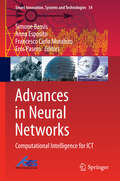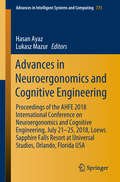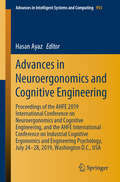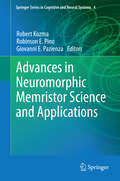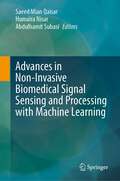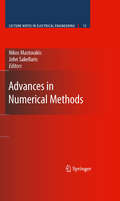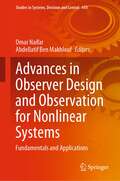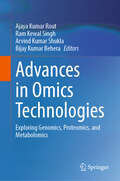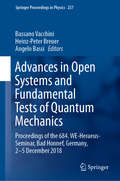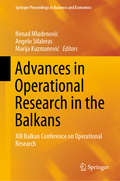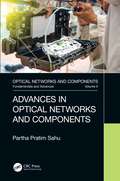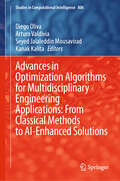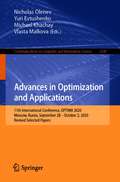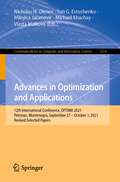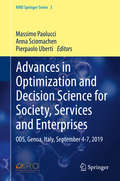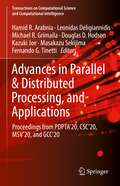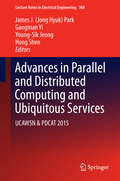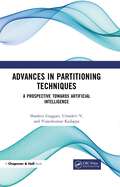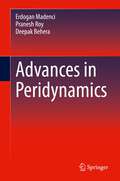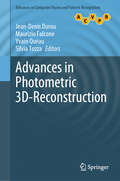- Table View
- List View
Advances in Neural Networks: Computational Intelligence for ICT (Smart Innovation, Systems and Technologies #54)
by Anna Esposito Francesco Carlo Morabito Simone Bassis Eros PaseroThis carefullyedited book is putting emphasis on computational and artificial intelligentmethods for learning and their relative applications in robotics, embeddedsystems, and ICT interfaces for psychological and neurological diseases. Thebook is a follow-up of the scientific workshop on Neural Networks (WIRN 2015)held in Vietri sul Mare, Italy, from the 20th to the 22nd of May 2015. Theworkshop, at its 27th edition became a traditional scientific event thatbrought together scientists from many countries, and several scientificdisciplines. Each chapter is an extended version of the original contributionpresented at the workshop, and together with the reviewers' peer revisions italso benefits from the live discussion during the presentation. The content of book is organized in the following sections. 1. Introduction, 2. Machine Learning, 3. Artificial Neural Networks: Algorithms and models, 4. Intelligent Cyberphysical and Embedded System, 5. Computational Intelligence Methods for Biomedical ICT in NeurologicalDiseases, 6. Neural Networks-Based Approaches to Industrial Processes, 7. Reconfigurable Modular Adaptive Smart Robotic Systems forOptoelectronics Industry: The White'R Instantiation This book is unique in proposing a holistic and multidisciplinaryapproach to implement autonomous, and complex Human Computer Interfaces.
Advances in Neuroergonomics and Cognitive Engineering: Proceedings of the AHFE 2018 International Conference on Neuroergonomics and Cognitive Engineering, July 21–25, 2018, Loews Sapphire Falls Resort at Universal Studios, Orlando, Florida USA (Advances in Intelligent Systems and Computing #775)
by Hasan Ayaz Lukasz MazurThis book offers a broad perspective on the field of cognitive engineering and neuroergonomics, covering emerging practices and future trends toward the harmonious integration of human operators and computer systems. It presents novel theoretical findings on mental workload and stress, activity theory, human reliability, error and risk, and neuroergonomic measures alike, together with a wealth of cutting-edge applications. Further, the book describes key advances in our understanding of cognitive processes, including mechanisms of perception, memory, reasoning, and motor response, with a special emphasis on their role in interactions between humans and other elements of computer-based systems. Based on the AHFE 2018 affiliated conference on Neuroergonomics and Cognitive Engineering, held on July 21–25, 2018, in Orlando, Florida, USA, it provides readers with a comprehensive overview of the current challenges in cognitive computing and factors influencing human performance.
Advances in Neuroergonomics and Cognitive Engineering: Proceedings of the AHFE 2019 International Conference on Neuroergonomics and Cognitive Engineering, and the AHFE International Conference on Industrial Cognitive Ergonomics and Engineering Psychology, July 24-28, 2019, Washington D.C., USA (Advances in Intelligent Systems and Computing #953)
by Hasan AyazThis book offers a broad perspective on the field of cognitive engineering and neuroergonomics, covering emerging practices and future trends toward the harmonious integration of human operators and computer systems. It presents novel theoretical findings on mental workload and stress, activity theory, human reliability, error and risk, and neuroergonomic measures alike, together with a wealth of cutting-edge applications. Further, the book describes key advances in our understanding of cognitive processes, including mechanisms of perception, memory, reasoning, and motor response, with a special emphasis on their role in interactions between humans and other elements of computer-based systems. Based on the AHFE 2019 affiliated conference on Neuroergonomics and Cognitive Engineering, held on July 24-28, 2019, in Washington D.C., USA, it provides readers with a comprehensive overview of the current challenges in cognitive computing and factors influencing human performance.
Advances in Neuromorphic Memristor Science and Applications (Springer Series in Cognitive and Neural Systems #4)
by Robinson E. Pino Robert Kozma Giovanni E. PazienzaPhysical implementation of the memristor at industrial scale sparked the interest from various disciplines, ranging from physics, nanotechnology, electrical engineering, neuroscience, to intelligent robotics. As any promising new technology, it has raised hopes and questions; it is an extremely challenging task to live up to the high expectations and to devise revolutionary and feasible future applications for memristive devices. The possibility of gathering prominent scientists in the heart of the Silicon Valley given by the 2011 International Joint Conference on Neural Networks held in San Jose, CA, has offered us the unique opportunity of organizing a series of special events on the present status and future perspectives in neuromorphic memristor science. This book presents a selection of the remarkable contributions given by the leaders of the field and it may serve as inspiration and future reference to all researchers that want to explore the extraordinary possibilities given by this revolutionary concept.
Advances in Neurotechnology, Electronics and Informatics: Revised Selected Papers from the 2nd International Congress on Neurotechnology, Electronics and Informatics (NEUROTECHNIX 2014), October 25-26, Rome, Italy (Biosystems & Biorobotics #12)
by Ana Rita Londral Pedro EncarnaçãoThis book is a timely report on current neurotechnology research. It presents a snapshot of the state of the art in the field, discusses current challenges and identifies new directions. The book includes a selection of extended and revised contributions presented at the 2nd International Congress on Neurotechnology, Electronics and Informatics (NEUROTECHNIX 2014), held October 25-26 in Rome, Italy. The chapters are varied: some report on novel theoretical methods for studying neuronal connectivity or neural system behaviour; others report on advanced technologies developed for similar purposes; while further contributions concern new engineering methods and technological tools supporting medical diagnosis and neurorehabilitation. All in all, this book provides graduate students, researchers and practitioners dealing with different aspects of neurotechnologies with a unified view of the field, thus fostering new ideas and research collaborations among groups from different disciplines.
Advances in Non-Invasive Biomedical Signal Sensing and Processing with Machine Learning
by Abdulhamit Subasi Saeed Mian Qaisar Humaira NisarThis book presents the modern technological advancements and revolutions in the biomedical sector. Progress in the contemporary sensing, Internet of Things (IoT) and machine learning algorithms and architectures have introduced new approaches in the mobile healthcare. A continuous observation of patients with critical health situation is required. It allows monitoring of their health status during daily life activities such as during sports, walking and sleeping. It is realizable by intelligently hybridizing the modern IoT framework, wireless biomedical implants and cloud computing. Such solutions are currently under development and in testing phases by healthcare and governmental institutions, research laboratories and biomedical companies. The biomedical signals such as electrocardiogram (ECG), electroencephalogram (EEG), Electromyography (EMG), phonocardiogram (PCG), Chronic Obstructive Pulmonary (COP), Electrooculography (EoG), photoplethysmography (PPG), and image modalities such as positron emission tomography (PET), magnetic resonance imaging (MRI) and computerized tomography (CT) are non-invasively acquired, measured, and processed via the biomedical sensors and gadgets. These signals and images represent the activities and conditions of human cardiovascular, neural, vision and cerebral systems. Multi-channel sensing of these signals and images with an appropriate granularity is required for an effective monitoring and diagnosis. It renders a big volume of data and its analysis is not feasible manually. Therefore, automated healthcare systems are in the process of evolution. These systems are mainly based on biomedical signal and image acquisition and sensing, preconditioning, features extraction and classification stages. The contemporary biomedical signal sensing, preconditioning, features extraction and intelligent machine and deep learning-based classification algorithms are described. Each chapter starts with the importance, problem statement and motivation. A self-sufficient description is provided. Therefore, each chapter can be read independently. To the best of the editors’ knowledge, this book is a comprehensive compilation on advances in non-invasive biomedical signal sensing and processing with machine and deep learning. We believe that theories, algorithms, realizations, applications, approaches, and challenges, which are presented in this book will have their impact and contribution in the design and development of modern and effective healthcare systems.
Advances in Non-Linear Modeling for Speech Processing (SpringerBriefs in Speech Technology)
by Mangesh S. Deshpande Raghunath S. HolambeAdvances in Non-Linear Modeling for Speech Processing includes advanced topics in non-linear estimation and modeling techniques along with their applications to speaker recognition. Non-linear aeroacoustic modeling approach is used to estimate the important fine-structure speech events, which are not revealed by the short time Fourier transform (STFT). This aeroacostic modeling approach provides the impetus for the high resolution Teager energy operator (TEO). This operator is characterized by a time resolution that can track rapid signal energy changes within a glottal cycle. The cepstral features like linear prediction cepstral coefficients (LPCC) and mel frequency cepstral coefficients (MFCC) are computed from the magnitude spectrum of the speech frame and the phase spectra is neglected. To overcome the problem of neglecting the phase spectra, the speech production system can be represented as an amplitude modulation-frequency modulation (AM-FM) model. To demodulate the speech signal, to estimation the amplitude envelope and instantaneous frequency components, the energy separation algorithm (ESA) and the Hilbert transform demodulation (HTD) algorithm are discussed. Different features derived using above non-linear modeling techniques are used to develop a speaker identification system. Finally, it is shown that, the fusion of speech production and speech perception mechanisms can lead to a robust feature set.
Advances in Numerical Methods (Lecture Notes in Electrical Engineering #11)
by Nikos Mastorakis John SakellarisRecent Advances in Numerical Methods features contributions from distinguished researchers, focused on significant aspects of current numerical methods and computational mathematics. The increasing necessity to present new computational methods that can solve complex scientific and engineering problems requires the preparation of this volume with actual new results and innovative methods that provide numerical solutions in effective computing times. Each chapter will present new and advanced methods and modern variations on known techniques that can solve difficult scientific problems efficiently.
Advances in Observer Design and Observation for Nonlinear Systems: Fundamentals and Applications (Studies in Systems, Decision and Control #410)
by Omar Naifar Abdellatif Ben MakhloufThis book discusses various methods for designing different kinds of observers, such as the Luenberger observer, unknown input observers, discontinuous observers, sliding mode observers, observers for impulsive systems, observers for nonlinear Takagi-Sugeno fuzzy systems, and observers for electrical machines. A hydraulic process system and a renewable energy system are provided as examples of applications.
Advances in Omics Technologies: Exploring Genomics, Proteomics, and Metabolomics
by Bijay Kumar Behera Ajaya Kumar Rout Ram Kewal Singh Arvind Kumar ShuklaThis comprehensive volume offers an in-depth exploration of the latest advancements in omics technologies and their practical applications across environmental science, agriculture, healthcare, and biotechnology. Covering key topics such as metagenomics for identifying beneficial microbes, bioremediation for environmental cleanup, bacteriophages, proteomics, epigenomics, and CRISPR-Cas9 genome editing, the book provides valuable insights into cutting-edge tools and methodologies. It also delves into next-generation sequencing, biosensor technology, bioinformatics tools, mass spectrometry-based metabolomics, as well as emerging fields like nutrigenomics and microarrays technology. With clear explanations and practical perspectives, this authoritative resource is ideal for students, researchers, and professionals striving to stay abreast of innovations in life sciences and contribute to the rapidly evolving landscape of omics sciences.
Advances in Open Systems and Fundamental Tests of Quantum Mechanics: Proceedings of the 684. WE-Heraeus-Seminar, Bad Honnef, Germany, 2–5 December 2018 (Springer Proceedings in Physics #237)
by Bassano Vacchini Heinz-Peter Breuer Angelo BassiQuantum mechanics has shown unprecedented success as a physical theory, but it has forced a new view on the description of physical reality. In recent years, important progress has been achieved both in the theory of open quantum systems and in the experimental realization and control of such systems. A great deal of the new results is concerned with the characterization and quantification of quantum memory effects. From this perspective, the 684. WE-Heraeus-Seminar has brought together scientists from different communities, both theoretical and experimental, sharing expertise on open quantum systems, as well as the commitment to the understanding of quantum mechanics. This book consists of many contributions addressing the diversified physics community interested in foundations of quantum mechanics and its applications and it reports about recent results in open quantum systems and their connection with the most advanced experiments testing quantum mechanics.
Advances in Operational Research in the Balkans: XIII Balkan Conference on Operational Research (Springer Proceedings in Business and Economics)
by Angelo Sifaleras Nenad Mladenović Marija KuzmanovićThis proceedings volume presents recent theoretical and practical advances in operational research (OR). The papers focus on a number of key areas including combinatorial optimization, integer programming, heuristics, and mathematical programming. In addition, this volume highlights OR applications in different areas such as financial decision making, marketing, e-business, project management, scheduling, traffic and transportation. The chapters are based on papers presented at the 13th Balkan Conference on Operations Research (BALCOR). BALCOR is an established biennial conference. The selected papers promote international collaboration among researchers and practitioners, with a particular focus on the Balkan countries.
Advances in Optical Networks and Components
by Partha Pratim SahuThis book is intended as a graduate/post graduate level textbook for courses on high-speed optical networks as well as computer networks. The ten chapters cover basic principles of the technology as well as latest developments and further discuss network security, survivability, and reliability of optical networks and priority schemes used in wavelength routing. This book also goes on to examine Fiber To The Home (FTTH) standards and their deployment and research issues and includes examples in all the chapters to aid the understanding of problems and solutions. Presents advanced concepts of optical network devices Includes examples and exercises inall the chapters of the book to aid the understanding of basic problems and solutions for undergraduate and postgraduate students Discusses optical ring metropolitan area networks and queuing system and its interconnection with other networks Discusses routing and wavelength assignment Examines restoration schemes in the survivability of optical networks
Advances in Optimization Algorithms for Multidisciplinary Engineering Applications: From Classical Methods to AI-Enhanced Solutions (Studies in Computational Intelligence #806)
by Diego Oliva Kanak Kalita Arturo Valdivia Seyed Jalaleddin MousaviradThis book is an authoritative compilation of the latest advancements in optimization techniques. This book covers a wide array of methods ranging from classical to metaheuristic to AI-enhanced approaches. The chapters are meticulously selected and organized in three sections—metaheuristics, machine learning and engineering applications. This allows for an in-depth exploration of diverse topics ranging from image processing to feature selection to data clustering, to practical applications like energy optimization, smart grids, healthcare diagnostics, etc. Each chapter delves into the specific algorithms and applications as well as provides ample theoretical insights. Accordingly, this book is ideally suited for undergraduate and postgraduate students in fields such as science, engineering and computational mathematics. It is also an invaluable resource for courses on artificial intelligence, computational intelligence, etc. Researchers and professionals in evolutionary computation, artificial intelligence and engineering will find the material especially useful for advancing their work and exploring new frontiers in optimization.
Advances in Optimization and Applications: 11th International Conference, OPTIMA 2020, Moscow, Russia, September 28 – October 2, 2020, Revised Selected Papers (Communications in Computer and Information Science #1340)
by Michael Khachay Vlasta Malkova Nicholas Olenev Yuri EvtushenkoThis book constitutes the refereed proceedings of the 11th International Conference on Optimization and Applications, OPTIMA 2020, held in September – October 2020. Due to the COVID-19 pandemic the conference was held online. The 18 revised full papers presented were carefully reviewed and selected from 60 submissions. The papers are organized intopical sections on global optimization; combinatorial and discrete optimization; optimal control; optimization in economy, finance and social sciences; applications.
Advances in Optimization and Applications: 12th International Conference, OPTIMA 2021, Petrovac, Montenegro, September 27 – October 1, 2021, Revised Selected Papers (Communications in Computer and Information Science #1514)
by Michael Khachay Milojica Jaćimović Vlasta Malkova Nicholas N. Olenev Yuri G. EvtushenkoThis book constitutes the refereed proceedings of the 12th International Conference on Optimization and Applications, OPTIMA 2021, held in Petrovac, Montenegro, in September - October 2021. Due to the COVID-19 pandemic the conference was partially held online. The 19 revised full papers presented were carefully reviewed and selected from 38 submissions. The papers are organized in topical sections on mathematical programming; global optimization; stochastic optimization; optimal control; mathematical economics; optimization in data analysis; applications.
Advances in Optimization and Applications: 14th International Conference, OPTIMA 2023, Petrovac, Montenegro, September 18–22, 2023, Revised Selected Papers (Communications in Computer and Information Science #1913)
by Michael Khachay Milojica Jaćimović Vlasta Malkova Nicholas Olenev Yuri EvtushenkoThis book constitutes the refereed proceedings of the 14th International Conference on Advances in Optimization and Applications, OPTIMA 2023, held in Petrovac, Montenegro, during September 18–22, 2023.The 21 full papers included in this book were carefully reviewed and selected from 68 submissions. They were organized in topical sections as follows: mathematical programming; global optimization; continuous optimization; discrete and combinatorial optimization; optimal control; game theory and mathematical economics; optimization in economics and finance; and applications.
Advances in Optimization and Decision Science for Society, Services and Enterprises: ODS, Genoa, Italy, September 4-7, 2019 (AIRO Springer Series #3)
by Massimo Paolucci Anna Sciomachen Pierpaolo UbertiThe contributions included in the volume are drawn from presentations at ODS2019 – International Conference on Optimization and Decision Science, which was the 49th annual meeting of the Italian Operations Research Society (AIRO) held at Genoa, Italy, on 4-7 September 2019. This book presents very recent results in the field of Optimization and Decision Science. While the book is addressed primarily to the Operations Research (OR) community, the interdisciplinary contents ensure that it will also be of very high interest for scholars and researchers from many scientific disciplines, including computer sciences, economics, mathematics, and engineering. Operations Research is known as the discipline of optimization applied to real-world problems and to complex decision-making fields. The focus is on mathematical and quantitative methods aimed at determining optimal or near-optimal solutions in acceptable computation times. This volume not only presents theoretical results but also covers real industrial applications, making it interesting for practitioners facing decision problems in logistics, manufacturing production, and services. Readers will accordingly find innovative ideas from both a methodological and an applied perspective.
Advances in Parallel & Distributed Processing, and Applications: Proceedings from PDPTA'20, CSC'20, MSV'20, and GCC'20 (Transactions on Computational Science and Computational Intelligence)
by Hamid R. Arabnia Leonidas Deligiannidis Fernando G. Tinetti Michael R. Grimaila Douglas D. Hodson Kazuki Joe Masakazu SekijimaThe book presents the proceedings of four conferences: The 26th International Conference on Parallel and Distributed Processing Techniques and Applications (PDPTA'20), The 18th International Conference on Scientific Computing (CSC'20); The 17th International Conference on Modeling, Simulation and Visualization Methods (MSV'20); and The 16th International Conference on Grid, Cloud, and Cluster Computing (GCC'20). The conferences took place in Las Vegas, NV, USA, July 27-30, 2020. The conferences are part of the larger 2020 World Congress in Computer Science, Computer Engineering, & Applied Computing (CSCE'20), which features 20 major tracks. Authors include academics, researchers, professionals, and students.Presents the proceedings of four conferences as part of the 2020 World Congress in Computer Science, Computer Engineering, & Applied Computing (CSCE'20);Includes the research tracks Parallel and Distributed Processing, Scientific Computing, Modeling, Simulation and Visualization, and Grid, Cloud, and Cluster Computing;Features papers from PDPTA’20, CSC’20, MSV’20, and GCC’20.
Advances in Parallel and Distributed Computing and Ubiquitous Services: UCAWSN & PDCAT 2015 (Lecture Notes in Electrical Engineering #368)
by Hong Shen James J. Jong Hyuk Park Gangman Yi Young-Sik JeongThis book contains the combined proceedings of the 4th International Conference on Ubiquitous Computing Application and Wireless Sensor Network (UCAWSN-15) and the 16th International Conference on Parallel and Distributed Computing, Applications and Technologies (PDCAT-15). The combined proceedings present peer-reviewed contributions from academic and industrial researchers in fields including ubiquitous and context-aware computing, context-awareness reasoning and representation, location awareness services, and architectures, protocols and algorithms, energy, management and control of wireless sensor networks. The book includes the latest research results, practical developments and applications in parallel/distributed architectures, wireless networks and mobile computing, formal methods and programming languages, network routing and communication algorithms, database applications and data mining, access control and authorization and privacy preserving computation.
Advances in Partitioning Techniques: A Prospective towards Artificial Intelligence
by Shankru Guggari Umadevi V Vijayakumar KadappaThis book discusses various partitioning strategies tailored for traditional machine learning algorithms. It examines how data can be divided efficiently to enhance the performance and scalability of classic machine learning models. It explores how partitioning methods can be applied to neural networks and other deep learning architectures and describes various ways to accelerate training, reduce memory consumption, and enhance overall efficiency.Graphs are prevalent in various AI domains. This book is specifically designed for graph data structures using partitioning techniques and also explores insights into optimizing graph algorithms and analytics. With the explosion of data, efficient partitioning becomes crucial for processing large datasets. This book discusses various partitioning techniques that enable effective management and analysis of big data, enhancing speed and resource utilization. Edge computing demands resource-efficient strategies. It examines partitioning methods tailored for edge devices, enabling AI capabilities at the edge while addressing resource. This book showcases how partitioning techniques have been successfully applied across various AI domains. It demonstrates real-world scenarios where partitioning optimizes AI algorithms and systems.By bridging the gap between theory and practical applications, this book intends to equip researchers, practitioners, and students with invaluable insights into harnessing partitioning for optimizing AI-driven systems, data processing, and problem-solving strategies. It describes the various advantages and disadvantages of partitioning techniques. This book is a vital resource, illuminating the path towards unlocking the full potential of partitioning in shaping the future of AI technologies.
Advances in Peridynamics
by Erdogan Madenci Pranesh Roy Deepak BeheraThis book presents recent improvements in peridynamic modeling of structures. It provides sufficient theory and numerical implementation helpful to both new and existing researchers in the field. The main focus of the book is on the non-ordinary state-based (NOSB) peridynamics (PD) and its applications for performing finite deformation. It presents the framework for modeling high stretch polymers, viscoelastic materials, thermoelasticity, plasticity, and creep. It provides a systematic derivation for dimensionally reduced structures such as axisymmetric structures and beams. Also, it presents a novel approach to impose boundary conditions without suffering from displacement kinks near the boundary. Furthermore, it presents refinements to bond-based PD model by including rotation kinematics for modeling isotropic and composite materials. Moreover, it presents a PD – FEM coupling framework in ANSYS based on principle for virtual work. Lastly, it presents an application of neural networks in the peridynamic (PINN) framework. Sample codes are provided for readers to develop hands-on experience on peridynamic modeling. Describes new developments in peridynamics and their applications in the presence of material and geometric nonlinearity; Describes an approach to seamlessly couple PD with FE; Introduces the use of the neural network in the PD framework to solve engineering problems;Provides theory and numerical examples for researchers and students to self-study and apply in their research (Codes are provided as supplementary material);Provides theoretical development and numerical examples suitable for graduate courses.
Advances in Photometric 3D-Reconstruction (Advances in Computer Vision and Pattern Recognition)
by Maurizio Falcone Jean-Denis Durou Yvain Quéau Silvia TozzaThis book presents the latest advances in photometric 3D reconstruction. It provides the reader with an overview of the state of the art in the field, and of the latest research into both the theoretical foundations of photometric 3D reconstruction and its practical application in several fields (including security, medicine, cultural heritage and archiving, and engineering). These techniques play a crucial role within such emerging technologies as 3D printing, since they permit the direct conversion of an image into a solid object. The book covers both theoretical analysis and real-world applications, highlighting the importance of deepening interdisciplinary skills, and as such will be of interest to both academic researchers and practitioners from the computer vision and mathematical 3D modeling communities, as well as engineers involved in 3D printing. No prior background is required beyond a general knowledge of classical computer vision models, numerical methods for optimization, and partial differential equations.
Advances in Physical Agents II: Proceedings of the 21st International Workshop of Physical Agents (WAF 2020), November 19-20, 2020, Alcalá de Henares, Madrid, Spain (Advances in Intelligent Systems and Computing #1285)
by Luis M. Bergasa Manuel Ocaña Rafael Barea Elena López-Guillén Pedro RevengaThe book reports on cutting-edge Artificial Intelligence (AI) theories and methods aimed at the control and coordination of agents acting and moving in a dynamic environment. It covers a wide range of topics relating to: autonomous navigation, localization and mapping; mobile and social robots; multiagent systems; human-robot interaction; perception systems; and deep-learning techniques applied to the robotics. Based on the 21st edition of the International Workshop of Physical Agents (WAF 2020), held virtually on November 19-20, 2020, from Alcalá de Henares, Madrid, Spain, this book offers a snapshot of the state-of-the-art in the field of physical agents, with a special emphasis on novel AI techniques in perception, navigation and human robot interaction for autonomous systems.
Advances in Physical Agents: Proceedings of the 19th International Workshop of Physical Agents (WAF 2018), November 22-23, 2018, Madrid, Spain (Advances in Intelligent Systems and Computing #855)
by Raquel Fuentetaja Pizán Ángel García Olaya Maria Paz Sesmero Lorente Jose Antonio Iglesias Martínez Agapito Ledezma EspinoThe book reports on cutting-edge theories and methods aimed at the control and coordination of agents acting and moving in a dynamic environment. It covers a wide range of systems, including multiagent systems, domotic agents, robotic manipulators, soccer robots, autonomous and semiautonomous robots, as well as systems for industrial applications. Advances in software agents, sensors, computer visions and other related areas are also thoroughly discussed and presented in detail. Based on the 19th edition of the International Workshop of Physical Agents (WAF 2018), held on November 22-23, 2018, in Madrid, Spain, this book offers a snapshot of the state-of-the-art in the field of physical agents, with a special emphasis on autonomous systems such as mobile robots, industrial process or other complex systems.
